On the Mechanical Behavior of LP-DED C103 Thin-Wall Structures
Abstract
1. Introduction
| Element | Nb | Hf | Ti | Zr | W | Ta |
|---|---|---|---|---|---|---|
| % | Bal. | 9.0–11.0 | 0.7–1.3 | <0.7 | <0.5 | <0.5 |
2. Materials and Methods
2.1. Surface Topography
2.2. Heat Treatment
2.3. Tensile Testing
2.4. Fatigue Testing
3. Results and Discussion
3.1. Surface Topography
3.2. Tensile Testing
3.3. Tensile Fractography
3.4. Fatigue Testing
3.5. Fatigue Fractography
4. Summary and Conclusions
- Subtracting the maximum peak height (Rp) twice from the caliper measured thickness provided the most accurate estimate of the load bearing area. The use of caliper-based measurements tends to underestimate the material properties. Additional work is required to characterize this approach for specimens printed at an angle with different surface roughness values for the upskin and downskin of the material.
- Mechanical properties of LP-DED C103 are greater than their wrought counterparts. The large grain size resulting from LP-DED led to properties below the reported EB-PBF and L-PBF values. Stress relief (SR) heat treatment schedule reduced both strength and ductility. Hot isostatic pressing (HIP) increased all properties above the as-built (AB) condition. This is a unique behavior to LP-DED C103 since HIP cycles are detrimental to L-PBF C103 due to induced grain growth. Additional exploratory work is required to develop heat treatment schedules that produce optimal mechanical properties.
- Fractography of the tensile specimens revealed mixed mode fracture composed of equiaxed dimples, highly elongated dimples, shear fracture, and transgranular fracture for all heat treatment–build orientation combinations. The dominant fracture mechanisms are thought to be unique for each build orientation studied in this work. Scanning electron microscope (SEM) images confirmed that the interlayers act as stress concentration sites for crack initiation when specimens are oriented vertical to the build direction. When the specimens are oriented horizontal to the build direction, the fracture appears to mainly propagate along the (01) plane.
- Fatigue results showed max life cycles ranging from 100 cycles to over 8000 cycles for 2% and 0.5% max strain level respectively. At the lowest max strain level, the samples did not reach runout target of 50,000 cycles. Additional testing is needed to evaluate the material’s response to high cycle fatigue (HCF) and establish a predictive life cycle model.
- Fractography of the fatigue specimens revealed consistent crack initiation sites along the edges of the samples within the interlayers. The cracks propagated across several deposited layers prior to the final fracture. As strain levels are increased, the crack propagation zone is increased. At the 0.5% max strain level, the specimen spends most of the test time under crack initiation and damage accumulation. At increased strain levels, crack propagation dominates for the majority of the time.
Author Contributions
Funding
Data Availability Statement
Acknowledgments
Conflicts of Interest
References
- Ciulik, J.R.; Shields, J.A.; Kumar, P.; Leonhardt, T.; Johnson, J.L. Properties and Selection of Powder Metallurgy Refractory Metals. In Powder Metallurgy; ASM International: Almere, The Netherlands, 2015; pp. 593–598. [Google Scholar] [CrossRef]
- Briant, C.L.; Banerjee, M.K. Refractory Metals and Alloys. In Reference Module in Materials Science and Materials Engineering; Elsevier: Amsterdam, The Netherlands, 2016. [Google Scholar] [CrossRef]
- Halchak, J.A.; Cannon, J.L.; Brown, C. Materials for Liquid Propulsion Systems. In Aerospace Materials and Applications; Progress in Astronautics and Aeronautics, American Institute of Aeronautics and Astronautics, Inc.: Las Vegas, NV, USA, 2018; pp. 641–698. [Google Scholar] [CrossRef]
- Wadsworth, J.; Roberts, C.A.; Rennhack, E.H. Creep behaviour of hot isostatically pressed niobium alloy powder compacts. J. Mater. Sci. 1982, 17, 2539–2546. [Google Scholar] [CrossRef]
- Ranjbar Motlagh, S.; Momeni, H.; Ehsani, N. Study on the Post-annealing Process of Nb-Hf Alloy Produced by Spark Plasma Sintering. Iran. J. Mater. Sci. Eng. 2021, 18, 110–117. [Google Scholar] [CrossRef]
- Mireles, O.; Rodriguez, O.; Gao, Y.; Philips, N. Additive Manufacture of Refractory Alloy C103 for Propulsion Applications. In Proceedings of the AIAA Propulsion and Energy 2020 Forum, Virtual, 24–28 August 2020. [Google Scholar] [CrossRef]
- Awasthi, P.D.; Agrawal, P.; Haridas, R.S.; Mishra, R.S.; Stawovy, M.T.; Ohm, S.; Imandoust, A. Mechanical properties and microstructural characteristics of additively manufactured C103 niobium alloy. Mater. Sci. Eng. A 2022, 831, 142183. [Google Scholar] [CrossRef]
- Milner, J.L.; Brizes, E. Elevated Temperature Mechanical Properties of L-PBF Niobium Alloy: C103. In Proceedings of the NTRS Author Affiliations: Glenn Research Center NTRS Meeting Information: 153rd Annual Meeting and Exhibition of The Minerals, Metals & Materials Society (TMS), Orlando, FL, USA, 3–7 March 2024; Undefined NTRS Document ID: 20240002294. NTRS Research Center, Glenn Research Center (GRC): Cleveland, OH, USA, 2024. [Google Scholar]
- Philips, N.R.; Carl, M.; Cunningham, N.J. New Opportunities in Refractory Alloys. Metall. Mater. Trans. A 2020, 51, 3299–3310. [Google Scholar] [CrossRef]
- Colón, B.J.; Watanabe, K.I.; Hobbs, T.J.; Romnes, C.J.; Mireles, O.R.; Murr, L.E.; Medina, F. Parameter development and characterization of laser powder directed energy deposition of Nb – Alloy C103 for thin wall geometries. J. Mater. Res. Technol. 2024, 30, 5028–5039. [Google Scholar] [CrossRef]
- Mazzarisi, M.; Errico, V.; Angelastro, A.; Campanelli, S.L. Influence of standoff distance and laser defocusing distance on direct laser metal deposition of a nickel-based superalloy. Int. J. Adv. Manuf. Technol. 2022, 120, 2407–2428. [Google Scholar] [CrossRef]
- ASTM B655; Standard Specification for Niobium-Hafnium Alloy Bar and Wire. ASTM: West Conshohocken, PJ, USA, 2024.
- Gradl, P.R.; Protz, C.S.; Wammen, T. Additive Manufacturing and Hot-fire Testing of Liquid Rocket Channel Wall Nozzles Using Blown Powder Directed Energy Deposition Inconel 625 and JBK-75 Alloys. In Proceedings of the AIAA Propulsion and Energy 2019 Forum, Indianapolis, IN, USA, 19–22 August 2019. [Google Scholar] [CrossRef]
- Gradl, P.R.; Teasley, T.W.; Protz, C.S.; Garcia, M.B.; Ellis, D.; Kantzos, C. Advancing GRCop-based Bimetallic Additive Manufacturing to Optimize Component Design and Applications for Liquid Rocket Engines. In AIAA Propulsion and Energy 2021 Forum, AIAA Propulsion and Energy Forum, Virtual, 9–11 August 2021; American Institute of Aeronautics and Astronautics: Las Vegas, NV, USA, 2021. [Google Scholar] [CrossRef]
- Gradl, P.R.; Teasley, T.W.; Protz, C.S.; Katsarelis, C.; Chen, P. Process Development and Hot-fire Testing of Additively Manufactured NASA HR-1 for Liquid Rocket Engine Applications. In Proceedings of the AIAA Propulsion and Energy 2021 Forum, Virtual, 9–11 August 2021; American Institute of Aeronautics and Astronautics: Las Vegas, NV, USA, 2021. [Google Scholar] [CrossRef]
- Roach, A.M.; White, B.C.; Garland, A.; Jared, B.H.; Carroll, J.D.; Boyce, B.L. Size-dependent stochastic tensile properties in additively manufactured 316L stainless steel. Addit. Manuf. 2020, 32, 101090. [Google Scholar] [CrossRef]
- Demeneghi, G.; Barnes, B.; Gradl, P.; Mayeur, J.R.; Hazeli, K. Size effects on microstructure and mechanical properties of additively manufactured copper–chromium–niobium alloy. Mater. Sci. Eng. A 2021, 820, 141511. [Google Scholar] [CrossRef]
- Brown, B.; Everhart, W.; Dinardo, J. Characterization of bulk to thin wall mechanical response transition in powder bed AM. Rapid Prototyp. J. 2016, 22, 801–809. [Google Scholar] [CrossRef]
- Ali, N.; Tomesani, L.; Ascari, A.; Fortunato, A. Fabrication of Thin Walls with and without Close Loop Control as a Function of Scan Strategy Via Direct Energy Deposition. Lasers Manuf. Mater. Process. 2022, 9, 81–101. [Google Scholar] [CrossRef]
- Mueller, M.; Franz, K.; Riede, M.; López, E.; Brueckner, F.; Leyens, C. Influence of process parameter variation on the microstructure of thin walls made of Inconel 718 deposited via laser-based directed energy deposition with blown powder. J. Mater. Sci. 2023, 58, 11310–11326. [Google Scholar] [CrossRef]
- Demeneghi, G.; Barnes, B.; Gradl, P.; Ellis, D.; Mayeur, J.R.; Hazeli, K. Directed energy deposition GRCop-42 copper alloy: Characterization and size effects. Mater. Des. 2022, 222, 111035. [Google Scholar] [CrossRef]
- Kok, Y.; Tan, X.P.; Wang, P.; Nai, M.L.S.; Loh, N.H.; Liu, E.; Tor, S.B. Anisotropy and heterogeneity of microstructure and mechanical properties in metal additive manufacturing: A critical review. Mater. Des. 2018, 139, 565–586. [Google Scholar] [CrossRef]
- Simpson, J.; Haley, J.; Cramer, C.; Shafer, O.; Elliott, A.; Peter, W.; Love, L.; Dehoff, R. Considerations for Application of Additive Manufacturing to Nuclear Reactor Core Components; Technical Report ORNL/TM-2019/1190; Oak Ridge National Laboratory: Oak Ridge, TN, USA, 2019; p. 1564201. [CrossRef]
- Liu, M.; Kumar, A.; Bukkapatnam, S.; Kuttolamadom, M. A Review of the Anomalies in Directed Energy Deposition (DED) Processes & Potential Solutions—Part Quality & Defects. Procedia Manuf. 2021, 53, 507–518. [Google Scholar] [CrossRef]
- Errico, V.; Posa, P.; Mazzarisi, M.; Angelastro, A.; Campanelli, S.L. Effects of Laser-Deposited Maraging Steel on L-PBF 316L Component. Metals 2022, 12, 1669. [Google Scholar] [CrossRef]
- ASTM E8; Standard Test Methods for Tension Testing of Metallic Materials. ASTM: West Conshohocken, PJ, USA, 2024.
- ASTM E606-21; Standard Test Method for Strain-Controlled Fatigue Testing. ASTM: West Conshohocken, PJ, USA, 2021.
- Diaz, A. 16—Surface texture characterization and optimization of metal additive manufacturing-produced components for aerospace applications. In Additive Manufacturing for the Aerospace Industry; Froes, F., Boyer, R., Eds.; Elsevier: Amsterdam, The Netherlands, 2019; pp. 341–374. [Google Scholar] [CrossRef]
- American Institute of Aeronautics and Astronautics. Mechanical Properties of Select AM Alloys. In Metal Additive Manufacturing for Propulsion Applications; Progress in Astronautics and Aeronautics; American Institute of Aeronautics and Astronautics, Inc.: Reston, VA, USA, 2022; pp. 717–774. [Google Scholar] [CrossRef]
- Gradl, P.R.; Cervone, A.; Gill, E. Surface texture characterization for thin-wall NASA HR-1 Fe–Ni–Cr alloy using laser powder directed energy deposition (LP-DED). Adv. Ind. Manuf. Eng. 2022, 4, 100084. [Google Scholar] [CrossRef]
- Maleki, E.; Bagherifard, S.; Bandini, M.; Guagliano, M. Surface post-treatments for metal additive manufacturing: Progress, challenges, and opportunities. Addit. Manuf. 2021, 37, 101619. [Google Scholar] [CrossRef]
- Pais, M.R.; Chow, L.C.; Mahefkey, E.T. Surface Roughness and Its Effects on the Heat Transfer Mechanism in Spray Cooling. J. Heat Transf. 1992, 114, 211–219. [Google Scholar] [CrossRef]
- Teasley, T.; Gradl, P.R.; Tinker, D.C.; Mireles, O.R.; Diaz, A. Component Performance and Application Characteristics. In Metal Additive Manufacturing for Propulsion Applications; Progress in Astronautics and Aeronautics; American Institute of Aeronautics and Astronautics, Inc.: Reston, VA, USA, 2022; pp. 527–592. [Google Scholar] [CrossRef]
- Tilson, W.G.; Katsarelis, C. SLM Inconel 718 Thin Section Study; NTRS Author Affiliations: Marshall Space Flight Center NTRS Report/Patent Number: MPFR-19-004 NTRS Document ID: 20205006448; NTRS Research Center; Marshall Space Flight Center (MSFC): Huntsville, AL, USA, 2020.
- Möller, N.; Hansson, S.O. Principles of engineering safety: Risk and uncertainty reduction. Reliab. Eng. Syst. Saf. 2008, 93, 798–805. [Google Scholar] [CrossRef]
- Margerit, P.; Weisz-Patrault, D.; Ravi-Chandar, K.; Constantinescu, A. Tensile and ductile fracture properties of as-printed 316L stainless steel thin walls obtained by directed energy deposition. Addit. Manuf. 2021, 37, 101664. [Google Scholar] [CrossRef]
- Yu, C.H.; Peng, R.L.; Luzin, V.; Sprengel, M.; Calmunger, M.; Lundgren, J.E.; Brodin, H.; Kromm, A.; Moverare, J. Thin-wall effects and anisotropic deformation mechanisms of an additively manufactured Ni-based superalloy. Addit. Manuf. 2020, 36, 101672. [Google Scholar] [CrossRef]
- Schneider, C.A.; Rasband, W.S.; Eliceiri, K.W. NIH Image to ImageJ: 25 years of Image Analysis. Nat. Methods 2012, 9, 671–675. [Google Scholar] [CrossRef] [PubMed]
- Dossett, J.L.; Totten, G.E. Steel Heat Treating Fundamentals and Processes; ASM International: Almere, The Netherlands, 2013; Volume 4A. [Google Scholar] [CrossRef]
- Laleh, M.; Sadeghi, E.; Revilla, R.I.; Chao, Q.; Haghdadi, N.; Hughes, A.E.; Xu, W.; De Graeve, I.; Qian, M.; Gibson, I.; et al. Heat treatment for metal additive manufacturing. Prog. Mater. Sci. 2023, 133, 101051. [Google Scholar] [CrossRef]
- Nguyen, H.D.; Pramanik, A.; Basak, A.K.; Dong, Y.; Prakash, C.; Debnath, S.; Shankar, S.; Jawahir, I.S.; Dixit, S.; Buddhi, D. A critical review on additive manufacturing of Ti-6Al-4V alloy: Microstructure and mechanical properties. J. Mater. Res. Technol. 2022, 18, 4641–4661. [Google Scholar] [CrossRef]
- Mfusi, B.J.; Mathe, N.R.; Tshabalala, L.C.; Popoola, P.A. The Effect of Stress Relief on the Mechanical and Fatigue Properties of Additively Manufactured AlSi10Mg Parts. Metals 2019, 9, 1216. [Google Scholar] [CrossRef]
- DebRoy, T.; Wei, H.L.; Zuback, J.S.; Mukherjee, T.; Elmer, J.W.; Milewski, J.O.; Beese, A.M.; Wilson-Heid, A.; De, A.; Zhang, W. Additive manufacturing of metallic components—Process, structure and properties. Prog. Mater. Sci. 2018, 92, 112–224. [Google Scholar] [CrossRef]
- Yadav, S.; Paul, C.P.; Jinoop, A.N.; Rai, A.K.; Bindra, K.S. Laser Directed Energy Deposition based Additive Manufacturing of Copper: Process Development and Material Characterizations. J. Manuf. Processes 2020, 58, 984–997. [Google Scholar] [CrossRef]
- Carroll, B.E.; Palmer, T.A.; Beese, A.M. Anisotropic tensile behavior of Ti–6Al–4V components fabricated with directed energy deposition additive manufacturing. Acta Mater. 2015, 87, 309–320. [Google Scholar] [CrossRef]
- AMS7857; Columbium (Niobium) Alloy Bars, Rods, and Extrusions 10Hf-1.0Ti, Recrystallization Annealed. SAE International: Troy, MI, USA, 1984.
- Li, C.; Liu, Z.Y.; Fang, X.Y.; Guo, Y.B. Residual Stress in Metal Additive Manufacturing. Procedia CIRP 2018, 71, 348–353. [Google Scholar] [CrossRef]
- Additive Manufacturing of Liquid Rocket Engine Combustion Devices: A Summary of Process Developments and Hot-Fire Testing Results. In Proceedings of the AIAA Propulsion and Energy Forum, Cincinnati, OH, USA, 9–11 July 2018.
- Hobbs, T.; Colon, B.; Beamer, C.; Tirado, F.R.; Romnes, C.; Mireles, O. Heat Treatment Optimization of Laser Powder Bed Fusion Additive Manufacture C103. In Proceedings of the 153rd Annual Meeting and Exhibition of The Minerals, Metals & Materials Society (TMS), Orlando, FL, USA, 3–7 March 2024; undefined NTRS Document ID: 20240002139. NTRS Research Center, Glenn Research Center (GRC): Cleveland, OH, USA, 2024. [Google Scholar]
- Hertzberg, R.W. Chapter 1: Tensile Response of Materials. In Deformation and Fracture Mechanics of Engineering Materials, 4th ed.; John Wiley & Sons, Inc.: Hoboken, NJ, USA, 1995; pp. 3–56. [Google Scholar]
- Schroeder, C.J.; Parrington, R.J.; Maciejewski, J.O.; Lane, J.F. ASM Handbook Volume 12: Fractography; ASM Handbook; ASM International: Almere, The Netherlands, 1987. [Google Scholar]
- Fonda, R.W.; Rowenhorst, D.J. Crystallographic Variability in Additive Manufacturing. In IOP Conference Series: Materials Science and Engineering; IOP Publishing: Bristol, UK, 2022; Volume 1249, p. 012007. [Google Scholar] [CrossRef]
- Philips, N.; Rock, C.; Cunningham, N.; Cooper, J.; Horn, T. Electron Beam Powder Bed Fusion of ATI C103TM Refractory Alloy. Metall. Mater. Trans. A 2024, 55, 2472–2484. [Google Scholar] [CrossRef]
- Wang, Z.; Wang, J.; Xu, S.; Liu, B.; Sui, Q.; Zhao, F.; Gong, L.; Liu, J. Influence of powder characteristics on microstructure and mechanical properties of Inconel 718 superalloy manufactured by direct energy deposition. Appl. Surf. Sci. 2022, 583, 152545. [Google Scholar] [CrossRef]
- Yu, C.H.; Leicht, A.; Peng, R.L.; Moverare, J. Low cycle fatigue of additively manufactured thin-walled stainless steel 316L. Mater. Sci. Eng. A 2021, 821, 141598. [Google Scholar] [CrossRef]
- Indeck, J. The Effect of Microstructural Defect Evolution during Elastic Fatigue Loading on Subsequent Mechanical Properties. Ph.D. Thesis, The University of Alabama in Huntsville, Huntsville, AL, USA, 2021. [Google Scholar]
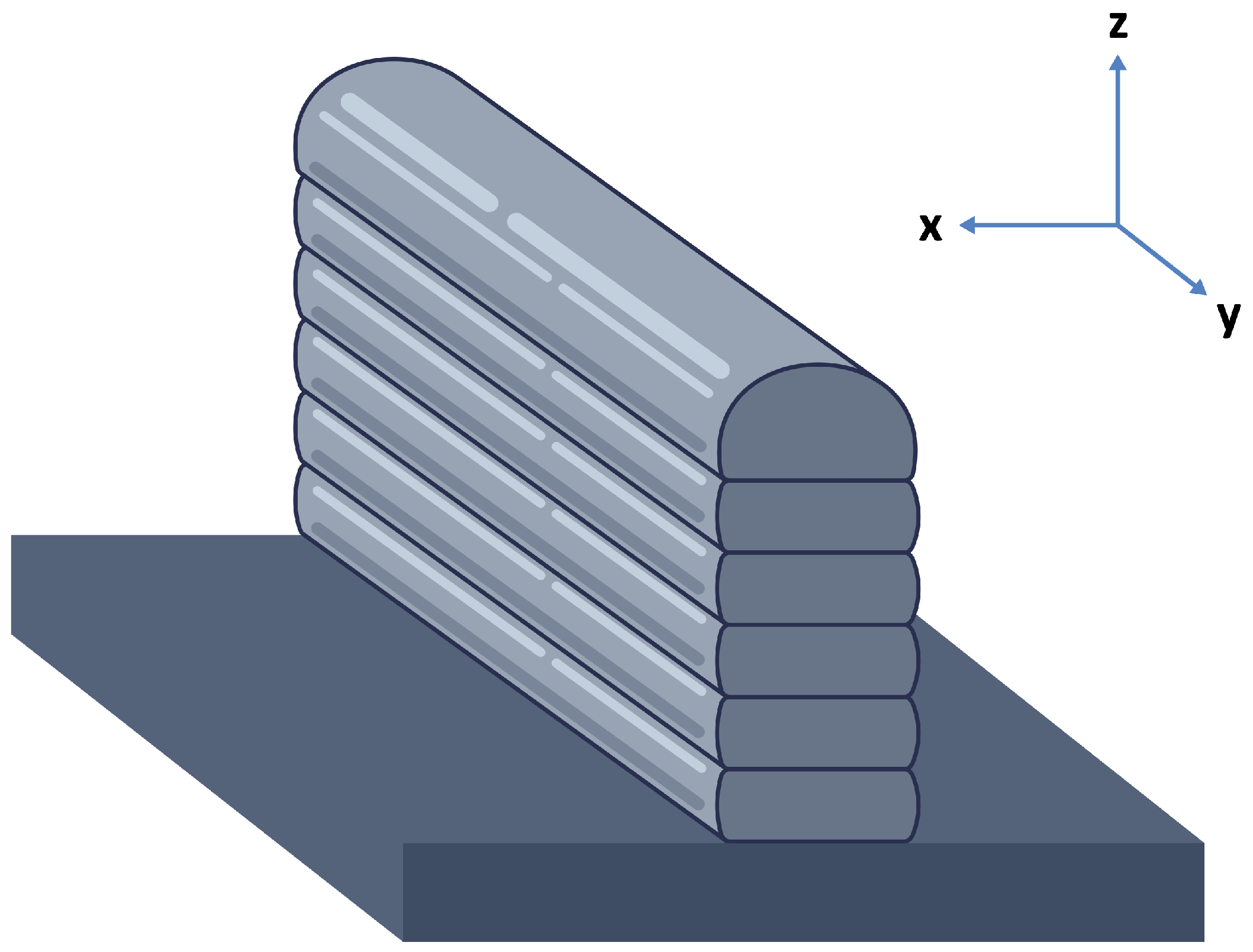

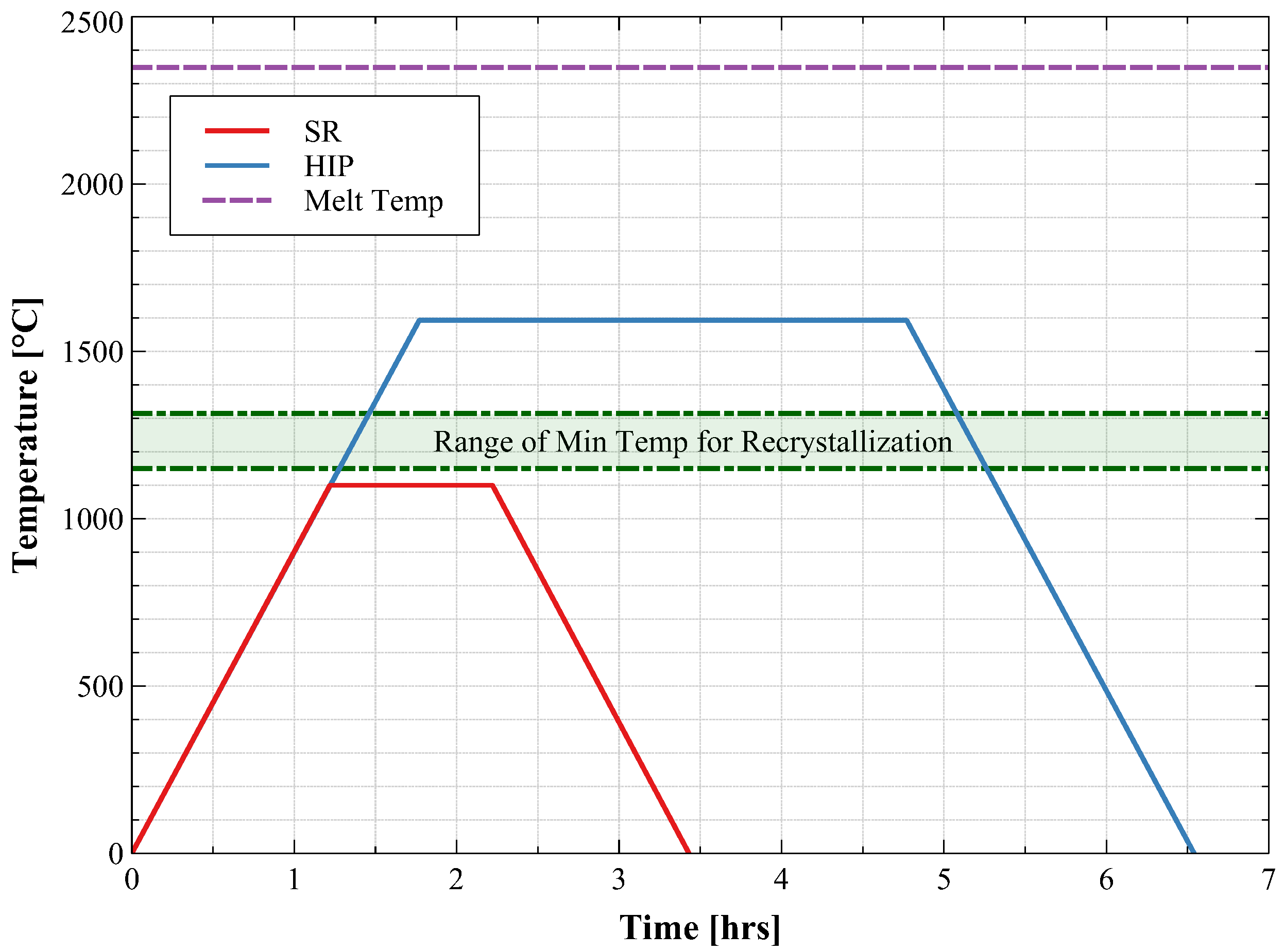


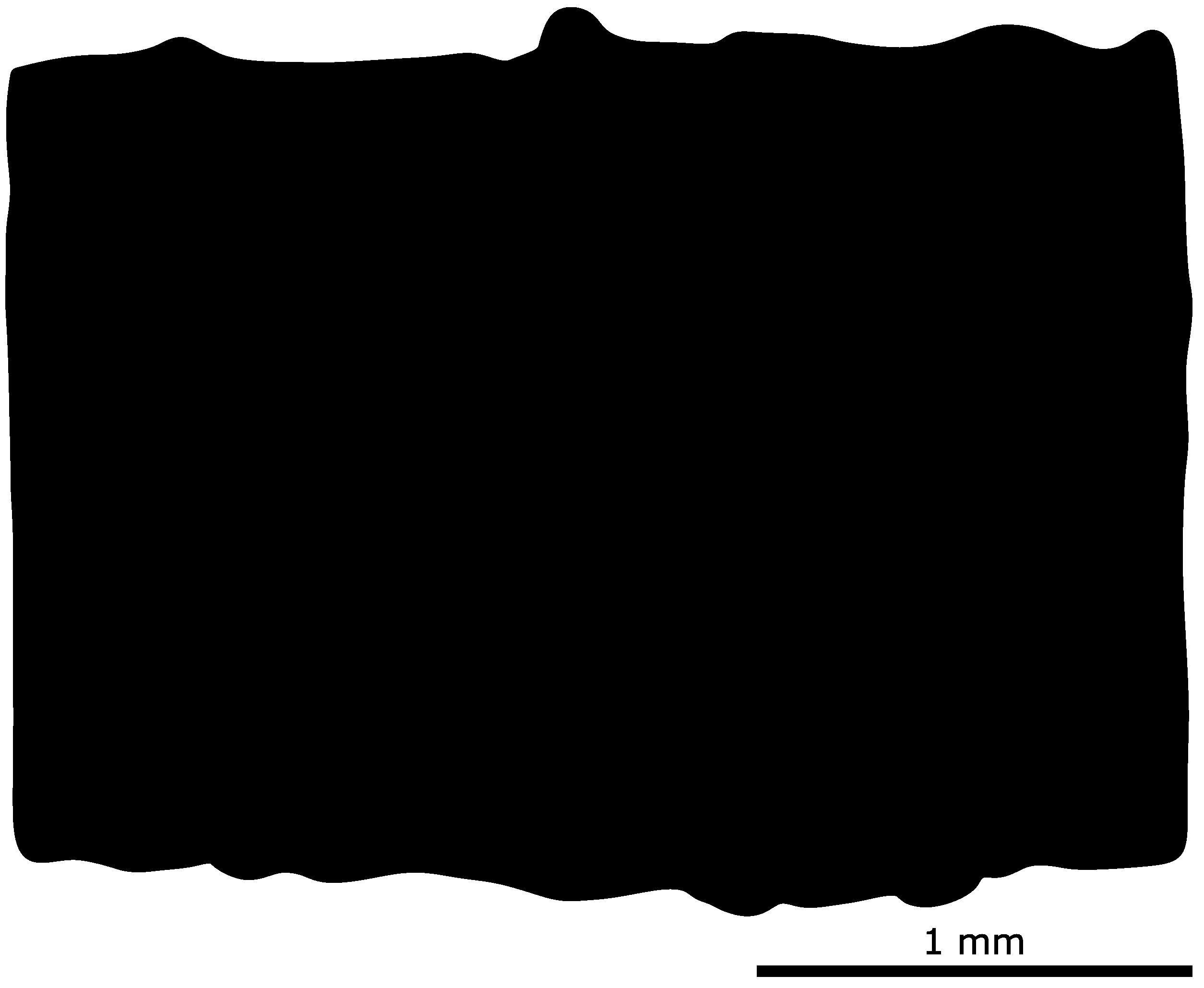

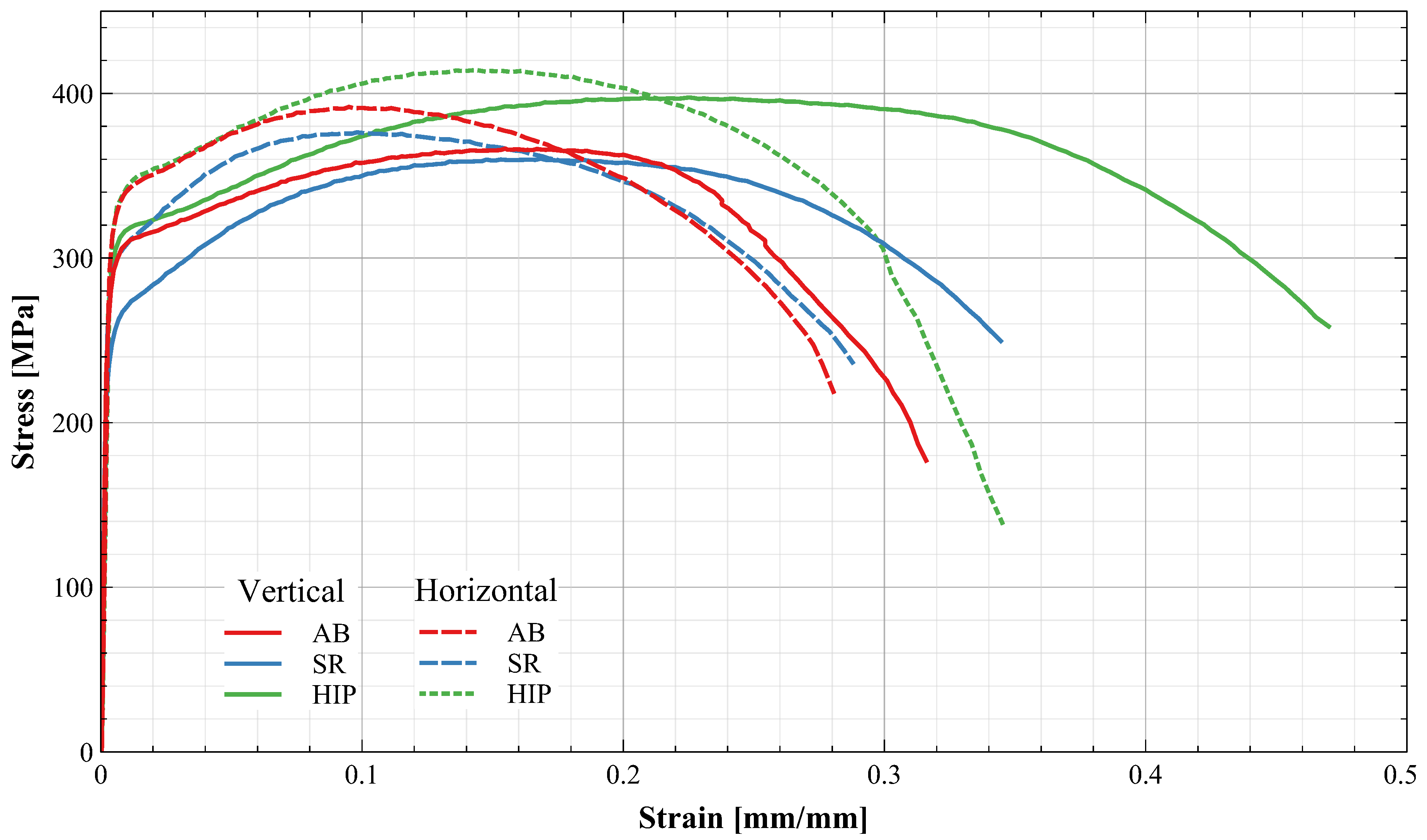
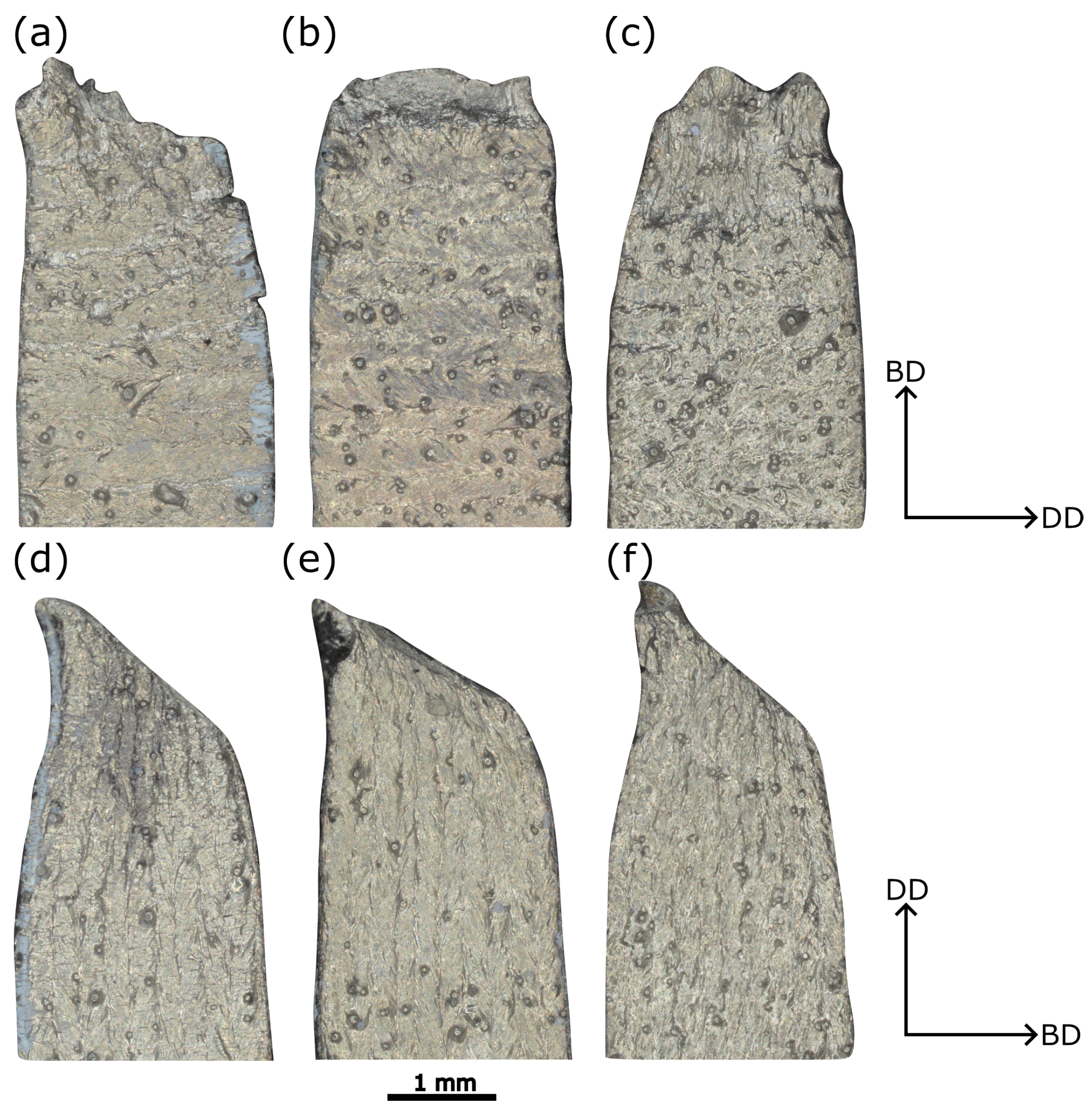

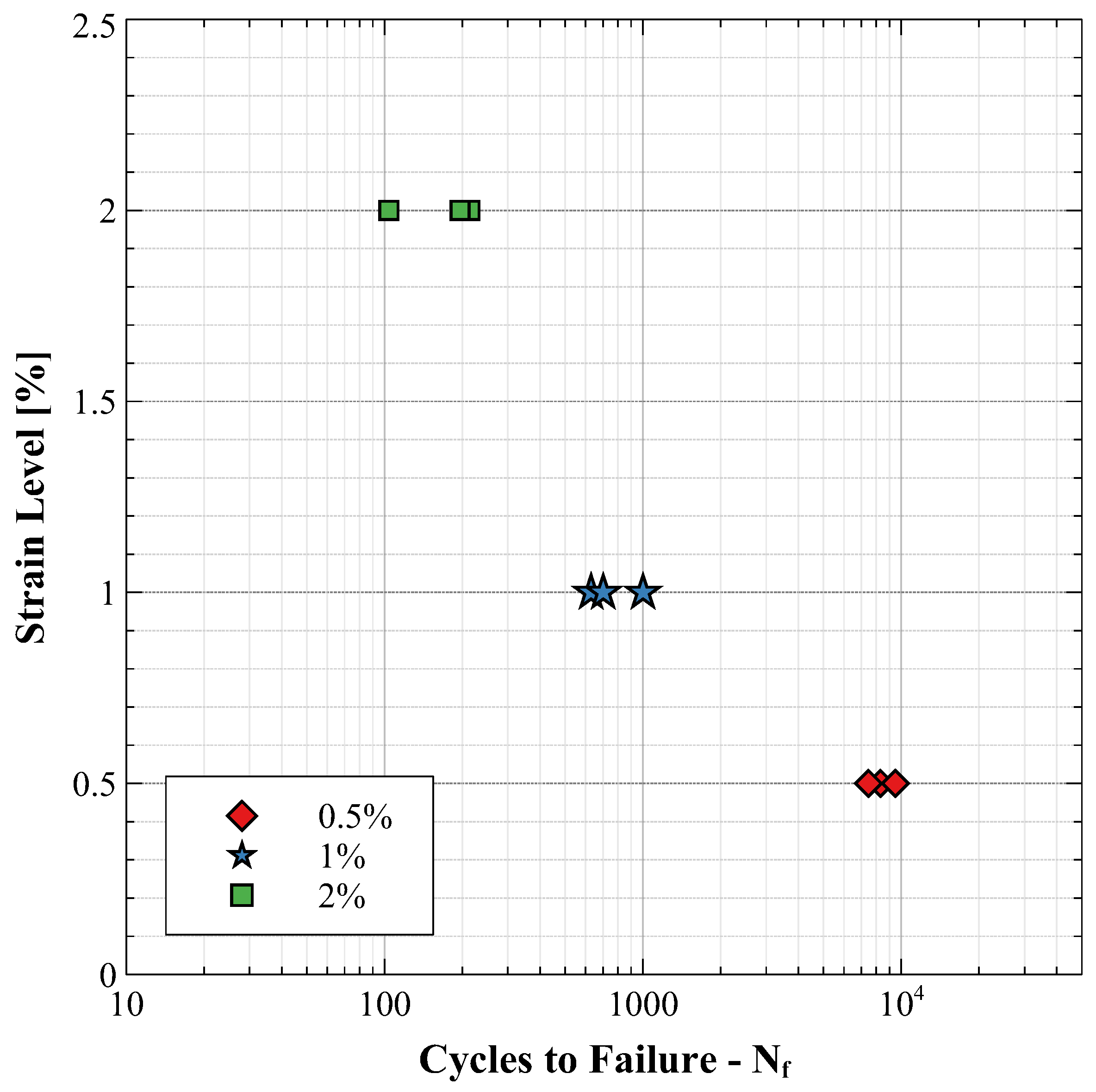
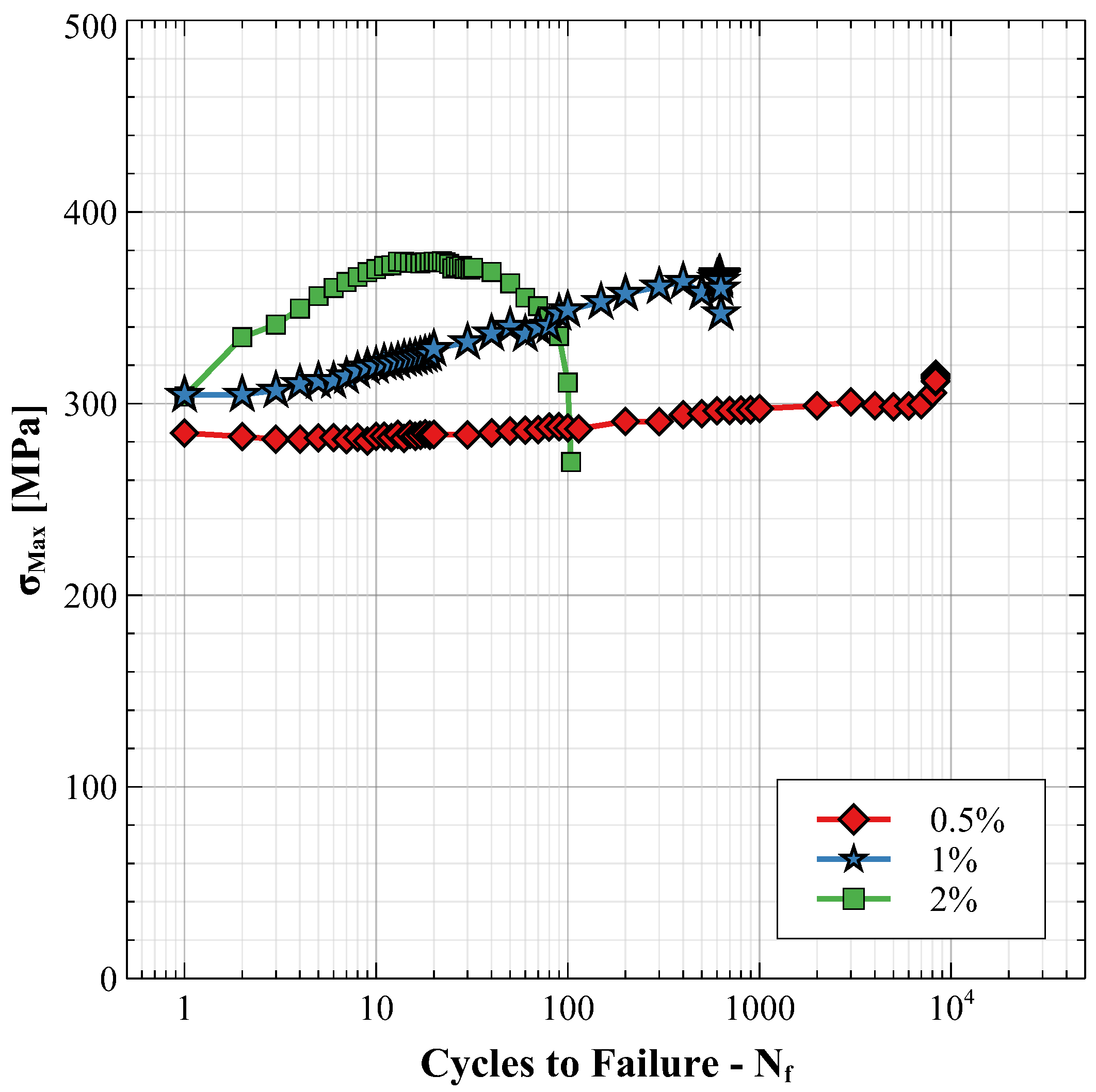

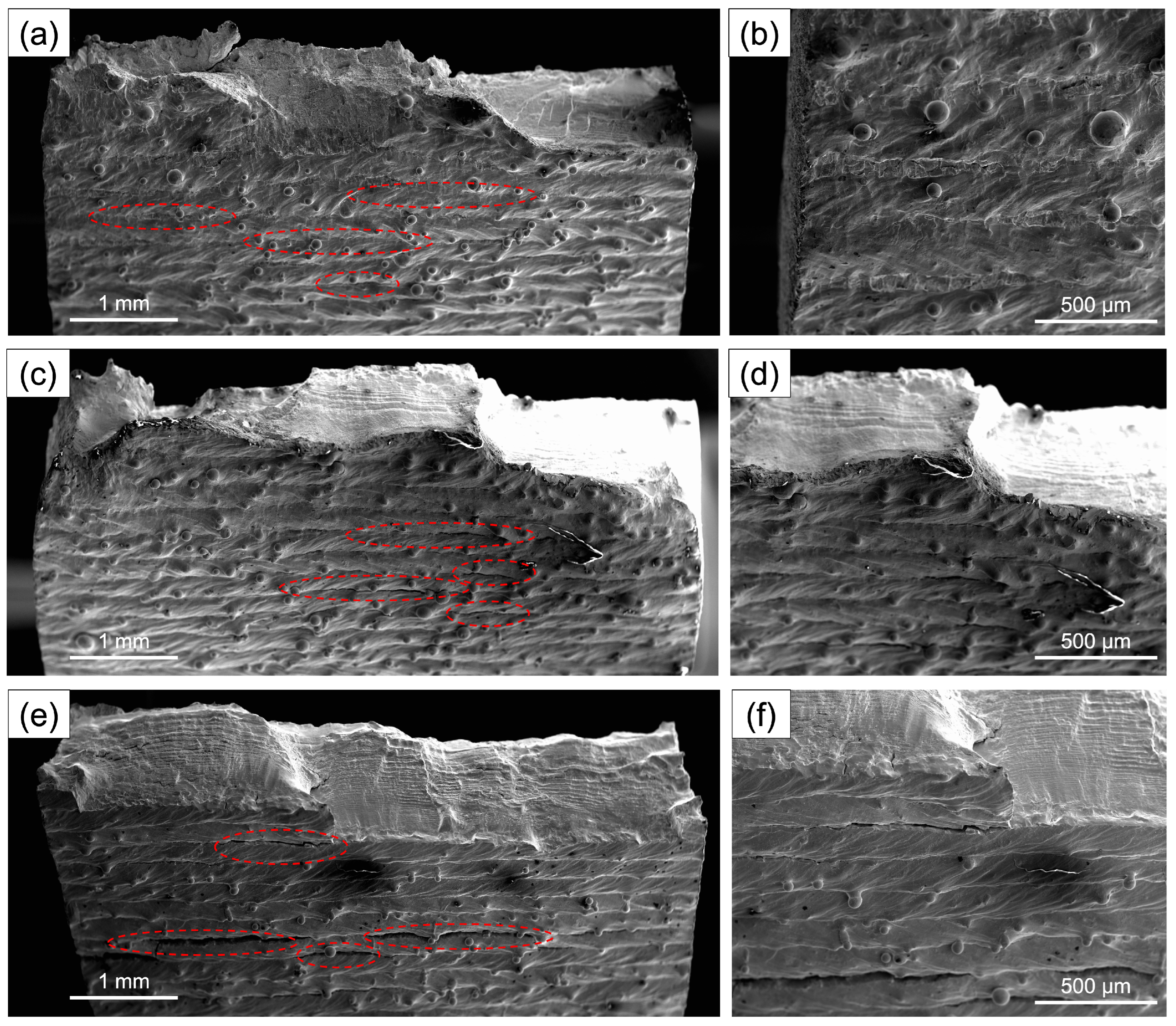
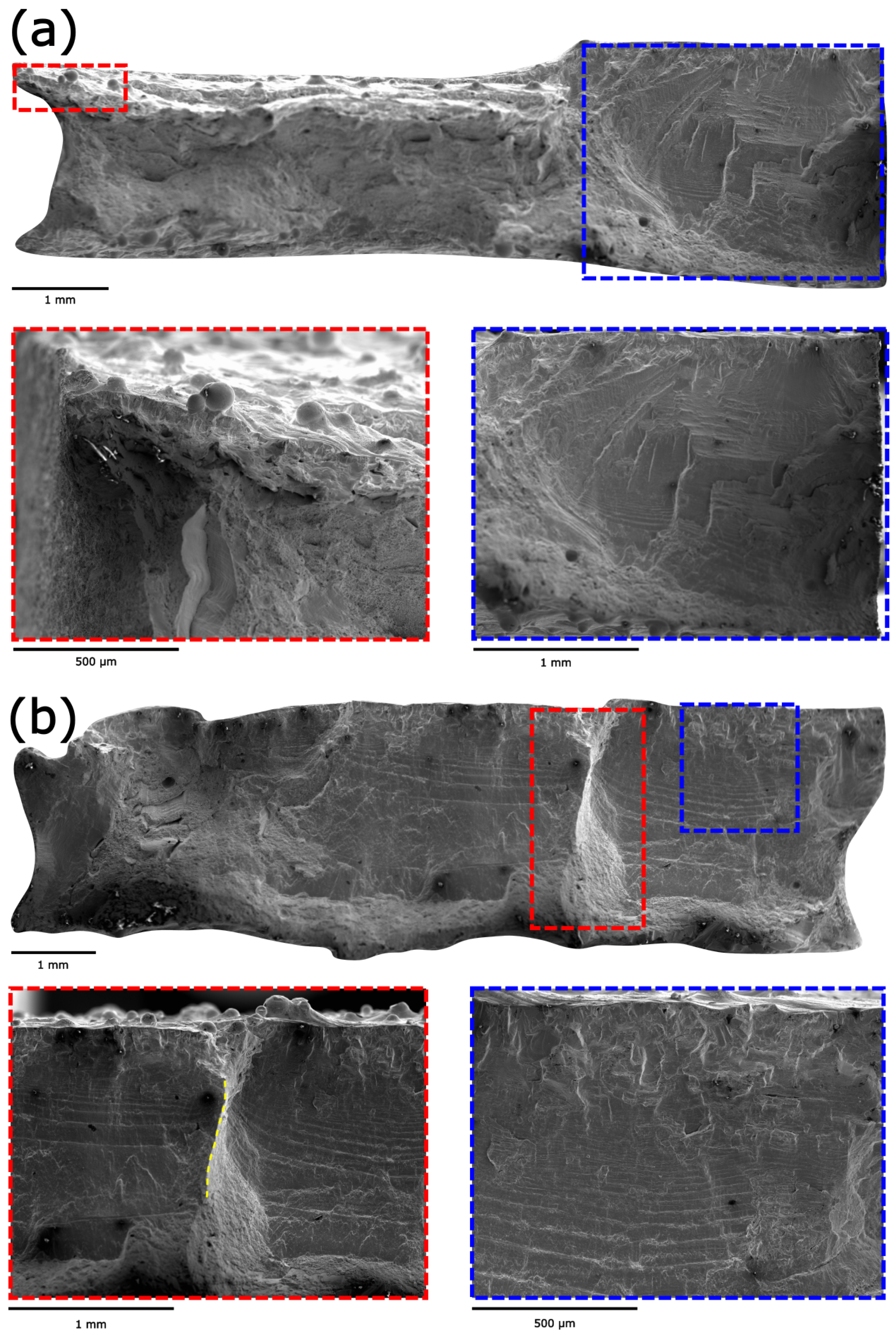

| Laser Power | Deposition Speed | Flow Rate | Laser Spot Size |
|---|---|---|---|
| 1420 W | 12.7 mm/min | 14.5 g/min | 1.4 mm |
| Ra [m] | Rp [m] | Rv [m] | Rz [m] | Sa [m] | Sp [m] | Sv [m] | Sz [m] |
|---|---|---|---|---|---|---|---|
| 17.92 ± 1.65 | 67.11 ± 3.55 | 47.77 ± 2.34 | 114.88 ± 1.65 | 14.66 ± 1.15 | 110.33 ± 8.73 | 58.00 ± 6.24 | 168.66 ± 10.21 |
| Measurement Technique | Area [mm2] | %Diff from Optical |
|---|---|---|
| Optical | 4.926 ± 0.105 | — |
| Calipers | 5.241 ± 0.039 | 6.37% |
| Ra | 5.150 ± 0.041 | 4.53% |
| Rp | 4.900 ± 0.056 | 0.54% |
| Rv | 4.998 ± 0.047 | 1.45% |
| Rz | 4.657 ± 0.065 | 5.46% |
| Sa | 5.166 ± 0.033 | 4.86% |
| Sp | 4.680 ± 0.006 | 4.99% |
| Sv | 4.946 ± 0.049 | 0.39% |
| Sz | 4.384 ± 0.028 | 11.01% |
| Vertical Orientation | Horizontal Orientation | |||||
|---|---|---|---|---|---|---|
| Heat Treatment | YS [MPa] | UTS [MPa] | %E | YS [MPa] | UTS [MPa] | %E |
| AB | 285.46 ± 6.50 | 370.92 ± 5.10 | 33.68 ± 1.86 | 316.56 ± 8.96 | 395.02 ± 1.75 | 32.80 ± 4.75 |
| SR | 241.85 ± 4.08 | 366.29 ± 4.47 | 35.82 ± 1.28 | 285.00 ± 3.95 | 378.84 ± 3.11 | 32.67 ± 3.39 |
| HIP | 296.23 ± 8.37 | 400.61 ± 2.03 | 44.48 ± 3.91 | 321.32 * | 418.07 * | 34.50 * |
| Wrought [9] | 283 | 411 | 41 | – | – | – |
Disclaimer/Publisher’s Note: The statements, opinions and data contained in all publications are solely those of the individual author(s) and contributor(s) and not of MDPI and/or the editor(s). MDPI and/or the editor(s) disclaim responsibility for any injury to people or property resulting from any ideas, methods, instructions or products referred to in the content. |
© 2024 by the authors. Licensee MDPI, Basel, Switzerland. This article is an open access article distributed under the terms and conditions of the Creative Commons Attribution (CC BY) license (https://creativecommons.org/licenses/by/4.0/).
Share and Cite
Colón, B.; Pourjam, M.; Demeneghi, G.; Hazeli, K.; Mireles, O.; Medina, F. On the Mechanical Behavior of LP-DED C103 Thin-Wall Structures. Metals 2024, 14, 958. https://doi.org/10.3390/met14090958
Colón B, Pourjam M, Demeneghi G, Hazeli K, Mireles O, Medina F. On the Mechanical Behavior of LP-DED C103 Thin-Wall Structures. Metals. 2024; 14(9):958. https://doi.org/10.3390/met14090958
Chicago/Turabian StyleColón, Brandon, Mehrdad Pourjam, Gabriel Demeneghi, Kavan Hazeli, Omar Mireles, and Francisco Medina. 2024. "On the Mechanical Behavior of LP-DED C103 Thin-Wall Structures" Metals 14, no. 9: 958. https://doi.org/10.3390/met14090958
APA StyleColón, B., Pourjam, M., Demeneghi, G., Hazeli, K., Mireles, O., & Medina, F. (2024). On the Mechanical Behavior of LP-DED C103 Thin-Wall Structures. Metals, 14(9), 958. https://doi.org/10.3390/met14090958






